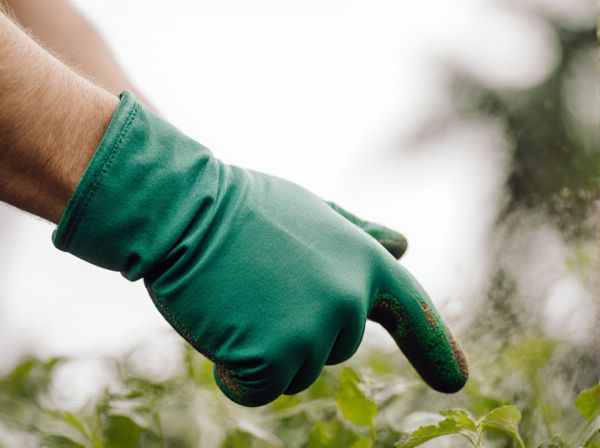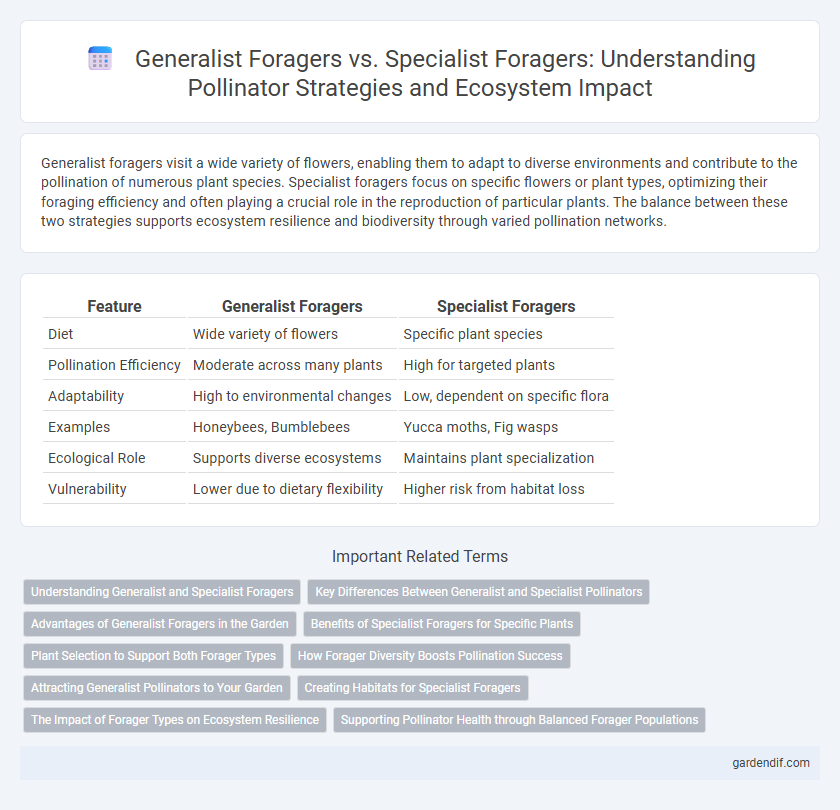
Generalist Foragers vs Specialist Foragers Illustration
Generalist foragers visit a wide variety of flowers, enabling them to adapt to diverse environments and contribute to the pollination of numerous plant species. Specialist foragers focus on specific flowers or plant types, optimizing their foraging efficiency and often playing a crucial role in the reproduction of particular plants. The balance between these two strategies supports ecosystem resilience and biodiversity through varied pollination networks.
Table of Comparison
| Feature | Generalist Foragers | Specialist Foragers |
|---|---|---|
| Diet | Wide variety of flowers | Specific plant species |
| Pollination Efficiency | Moderate across many plants | High for targeted plants |
| Adaptability | High to environmental changes | Low, dependent on specific flora |
| Examples | Honeybees, Bumblebees | Yucca moths, Fig wasps |
| Ecological Role | Supports diverse ecosystems | Maintains plant specialization |
| Vulnerability | Lower due to dietary flexibility | Higher risk from habitat loss |
Understanding Generalist and Specialist Foragers
Generalist foragers, such as honeybees, collect nectar and pollen from a wide variety of flowering plant species, enhancing pollination across diverse ecosystems and providing resilience against environmental changes. Specialist foragers, like certain solitary bee species, rely on a narrow range of host plants, resulting in highly efficient pollination of specific flowers but increased vulnerability to habitat loss and floral scarcity. Understanding the ecological roles and evolutionary adaptations of generalist and specialist pollinators is critical for biodiversity conservation and agricultural productivity.
Key Differences Between Generalist and Specialist Pollinators
Generalist pollinators, such as honeybees, forage on a wide variety of flowering plants, enabling them to adapt to diverse ecosystems and fluctuating floral resources. Specialist pollinators, like certain species of bees and butterflies, exhibit a narrow floral preference, often co-evolving with specific plant species for exclusive mutualistic relationships. The key differences lie in dietary breadth, ecological adaptability, and the degree of dependency on particular plant species, affecting pollination efficiency and biodiversity maintenance.
Advantages of Generalist Foragers in the Garden
Generalist foragers excel in the garden by collecting nectar and pollen from a wide variety of flowers, enhancing pollination diversity and boosting plant productivity. Their adaptable foraging behavior increases resilience against floral scarcity or seasonal changes, ensuring continuous pollination services. This flexibility supports ecosystem stability and promotes a richer, more vibrant garden habitat.
Benefits of Specialist Foragers for Specific Plants
Specialist foragers, such as certain bee species adapted to specific flowers, enhance pollination efficiency by matching their morphology and behavior to particular plant structures. This precise interaction improves pollen transfer and fruit set in plants like yucca and squash, which depend on specialized pollinators for reproduction. The close evolutionary relationship between specialist foragers and their host plants promotes biodiversity and ecosystem stability in habitats with diverse flowering species.
Plant Selection to Support Both Forager Types
Generalist foragers visit a wide variety of flowering plants, thriving on diverse floral resources, while specialist foragers rely on specific plant species for nutrition and reproduction. Designing pollinator-friendly habitats with a mix of native wildflowers, flowering shrubs, and trees ensures continuous bloom periods and caters to both generalist and specialist needs. Incorporating plant diversity supports pollinator health, enhances ecosystem resilience, and promotes effective pollination services across various environments.
How Forager Diversity Boosts Pollination Success
Forager diversity, including both generalist and specialist pollinators, significantly enhances pollination success by ensuring a broader range of floral resources is utilized and different plants receive targeted pollination. Generalist foragers, which visit multiple plant species, provide consistent pollination across diverse environments, while specialist foragers focus on specific plants, maximizing pollination efficiency and reproductive success for those species. This complementary foraging behavior increases overall pollination stability, promotes plant biodiversity, and improves crop yields in ecosystems reliant on pollination.
Attracting Generalist Pollinators to Your Garden
Generalist pollinators, such as honeybees and bumblebees, visit a wide variety of flowers, making them essential for diverse garden ecosystems. Planting a mix of native wildflowers, herbs, and flowering shrubs with staggered bloom times can effectively attract and sustain these generalist foragers. Creating habitats with continuous nectar and pollen sources encourages robust pollinator activity and enhances overall garden biodiversity.
Creating Habitats for Specialist Foragers
Creating habitats tailored for specialist foragers involves planting native flora that provides the specific pollen and nectar resources these pollinators require. Unlike generalist foragers, specialist pollinators depend on a narrow range of plant species, making habitat diversity and plant specificity crucial for their survival. Conserving and restoring native plant communities enhances ecosystem resilience and supports specialist forager populations essential for pollination services.
The Impact of Forager Types on Ecosystem Resilience
Generalist foragers, such as honeybees, visit a wide variety of plant species, enhancing pollination across diverse floral communities and promoting ecosystem stability. Specialist foragers, like certain orchid bees, focus on specific plants, increasing the reproductive success of targeted species and supporting specialized plant-pollinator relationships. The balance between generalist and specialist foragers strengthens ecosystem resilience by ensuring both broad ecological coverage and the preservation of specialized mutualisms critical for biodiversity.
Supporting Pollinator Health through Balanced Forager Populations
Maintaining balanced populations of generalist and specialist foragers enhances pollinator health by promoting diverse floral resource utilization and ecosystem resilience. Generalist foragers contribute to pollination across multiple plant species, while specialist foragers ensure effective reproduction of specific flora. Supporting habitats that accommodate both forager types strengthens pollination networks and boosts biodiversity.
Generalist Foragers vs Specialist Foragers Infographic

 gardendif.com
gardendif.com